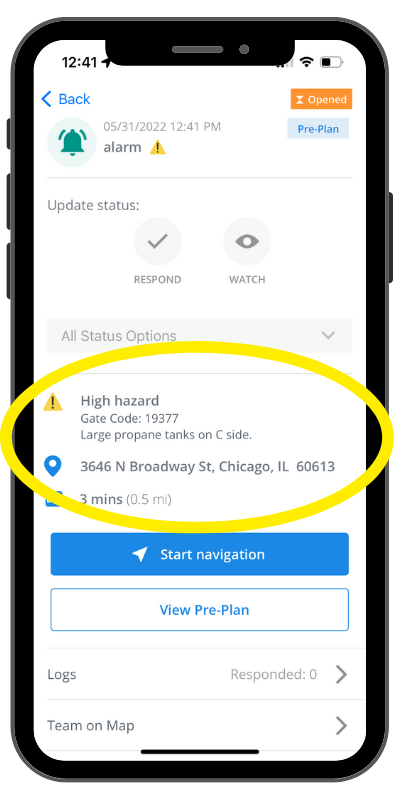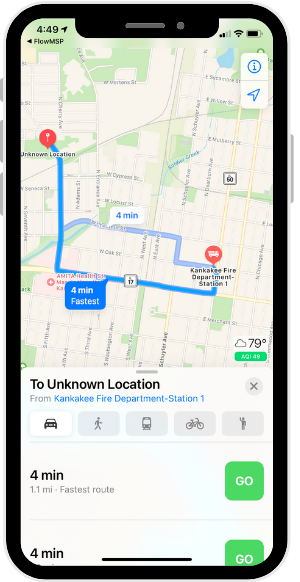Improving fire operations is possible today with modern technology. Advancement in computer software for the fire service means incident commanders now have immediate access to better information to help them make the right decisions on every call.
Historically this information lived in three places:
While these sources will always provide a certain amount of value, they can often be faulty and provide an incomplete picture of a location’s hazards. How can incident commanders gain a more complete and accurate foundation for decision-making?

The first piece of valuable information incident commanders need for successful fire operations is accurate incident notifications. The delivery system for these messages must be reliable and clearly communicate all known incident-related details, such as:
Modern technology increases the speed and accuracy of communication. As a result, departments now receive dispatch notifications faster than ever.
Most fire departments now receive this information from a computer-aided dispatch system or response app.

In addition, some digital programs deliver high hazard notes to call attention to special information at a particular location.
This gives first responders at-a-glance information about any hazards present while en route.
As a result, first responders save time during response because they don’t have to look up information or wait for someone else to provide it.
When responding to an unfamiliar location, field personnel need accurate directions. Previously, drivers referred to wall maps or map books to determine which route to take. However, modern technology now puts a map into every firefighter’s pocket on their mobile phones.

Most people now carry a smartphone which contains a mapping tool that gives turn-by-turn directions.
These powerful, satellite-based maps work with many response apps to provide mapping and routing to a specific incident location with a single touch.
The speed and accuracy with which personnel can identify a correct address and navigate there continues to improve.
Some technology even exists to identify when a railroad crossing will be blocked by a train. Responders with this information can take a different route and arrive faster.
Do you know the locations of all the water supply sources in your response area? How about the flow rates on hydrants, and whether or not a hydrant is in or out of service? How will you find your hydrants at night, in heavy smoke, or in the snow?

Fire personnel who know their water supply make better decisions about which sources to tag first.
As a result, first responders can save valuable time on fire suppression and maximize protection of life and property for that occupant.
Modern technology now equips fire departments to indicate hydrant locations and flow rates on a digital map.
These records are easy to update when a hydrant goes in or out of service, so fire personnel always know their water supply when making tactical assignments.
Every firefighter knows the value of a complete, accurate NFPA 1620 pre-incident plan. However, incident commanders have historically not had time to locate and review the correct pre-incident plan in the time between notification and arrival on scene.
In addition, pre-plans have historically been time-consuming to create, distribute, and update. As a result, many departments struggled to complete pre-plans and keep them up-to-date. For many locations there was either no pre-plan, or one so old that it was no longer useful.

Again, modern technology is improving fire operations by increasing the speed and ease of data collection and data delivery.
Now a firefighter can complete a pre-incident plan in five minutes instead of an hour. Departments can finally create and maintain accurate pre-plans.
More importantly, incident commanders can now instantly access pre-incident plans en route to an incident.
A single tap on a dispatch notification pulls up pictures, floor plans, building and owner contact information, and high hazard notes. All are useful in decision-making.
As a result of modern technology, the incident commander no longer needs to rely solely on memory, paper plans, or building owner accounts. They can make the best possible decisions using the most complete and up-to-date information, all available at the touch of a button.
Because information is now easier to collect and access, operations personnel gain greater control over what they can review during response. As a result, tactical decision-making improves, and so do incident outcomes.
Ultimately the goal is to use modern technology to its fullest potential to get the job done and bring everyone home safe. “Old-school” departments who want to improve fire operations will benefit from starting to explore modern solutions.
If you want to see how FlowMSP’s operations tools could help your department improve fire operations, request a web demo. A team member from FlowMSP will give you a personal tour of how the program works and answer any questions you may have.
If you want to stay informed about FlowMSP news and new features, subscribe to the FlowMSP email list. You may unsubscribe anytime.